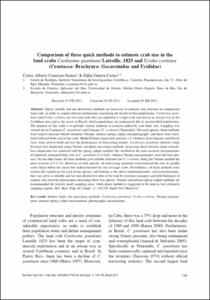| dc.contributor.author | Carmona-Suárez, Carlos | |
| dc.contributor.author | Guerra-Castro, Edlin | |
| dc.date.accessioned | 2023-05-14T19:34:10Z | |
| dc.date.available | 2023-05-14T19:34:10Z | |
| dc.date.issued | 2012 | |
| dc.identifier.citation | Carmona-Suárez, Carlos Alberto, and Edlin Guerra-Castro (2012) Comparison of three quick methods to estimate crab size in the land crabs Cardisoma guanhumi Latreille, 1825 and Ucides cordatus (Crustacea: Brachyura: Gecarcinidae and Ucididae). Revista de Biología Tropical, 60: Suppl. 1, pp.139-149. DOI: https://doi.org/10.15517/rbt.v60i0.19854 | en_US |
| dc.identifier.issn | 0034-7744 | |
| dc.identifier.uri | https://repository.oceanbestpractices.org/handle/11329/2217 | |
| dc.description.abstract | Quick, reliable and non destructive methods are necessary to estimate size structure on commercial
land crabs, in order to acquire relevant information concerning the health of their populations. Cardisoma guanhumi
and Ucides cordatus are two land crabs that are exploited at a high scale and also in an artisan way in the
Caribbean area and in the coasts of Brazil, which populations are endangered due to uncontrolled exploitation.
The purpose of this work is to provide various methods to estimate indirectly crab body size. Sampling was
carried out in Carenero (C. guanhumi) and Cumaná (U. cordatus) (Venezuela). For each species, three methods
were used to measure burrow diameter (Vernier, internal spring caliper and photograph), and these were correlated
with real body size of the crabs. Model II linear regression analyzes, i.e. Ordinary Least Squares and Mayor
Axis, were used to build and test the performance of forecasting models. Cardisoma guanhumi showed a high
bivariate data dispersion using Vernier and photo measuring methods, increasing these towards larger animals.
Less dispersion was achieved with the spring caliper method; this resulted in the most accurate measurements
of indirectly estimated body size in C. guanhumi (r2= 0.61), whereas Vernier measurements were the least precise.
On the other hand, all three methods gave reliable estimates for U. cordatus, being the Vernier method the
most accurate (r2= 0.71). However, in both species, all forecasting equations overestimated the size of smaller
crabs (those below the mean) but underestimated the size of larger crabs. Nevertheless, all three methods were
statistically significant for each of the species, and looking at the above mentioned under- and overestimations,
they can serve as reliable and fast non-destructive tools to be used by resource managers and field biologists to
acquire size structure information concerning these two species. Vernier and internal spring caliper methods are
recommended for relative small sampling areas, while photo method is suggested to be used in very extensive
sampling regions. | en_US |
| dc.language.iso | en | en_US |
| dc.subject.other | Vernier measurement | en_US |
| dc.subject.other | Internal spring caliper measurement | en_US |
| dc.subject.other | Body size measurement | en_US |
| dc.title | Comparison of three quick methods to estimate crab size in the land crabs Cardisoma guanhumi Latreille, 1825 and Ucides cordatus (Crustacea: Brachyura: Gecarcinidae and Ucididae). | en_US |
| dc.type | Journal Contribution | en_US |
| dc.description.notes | Volume 60 – Supplement 1 – March 2012: Proceedings of the 35th Scientific Meeting of the Association of Marine Laboratories of the Caribbean (AMLC) | en_US |
| dc.description.refereed | Refereed | en_US |
| dc.format.pagerange | pp.139-149 | en_US |
| dc.identifier.doi | https://doi.org/10.15517/rbt.v60i0.19854 | |
| dc.subject.parameterDiscipline | Other biological measurements | en_US |
| dc.subject.instrumentType | cameras | en_US |
| dc.subject.instrumentType | Vernier | en_US |
| dc.subject.dmProcesses | Data acquisition | en_US |
| dc.subject.dmProcesses | Data analysis | en_US |
| dc.description.abstractOtherLang | Spanish: Para la estimación de la estructura de tamaños en cangrejos terrestres comerciales y la obtención de información relevante para su manejo, es necesario utilizar métodos rápidos, confiables y no destructivos. Cardisoma guanhumi y Ucides cordatus son dos cangrejos terrestres que son explotados comercialmente en el Caribe y en Brasil. El propósito de este trabajo es suministrar métodos indirectos para la estimación del tamaño del caparazón de los cangrejos y por consiguiente, de la estructura de tallas. Los muestreos se llevaron a cabo en Carenero (C. guanhumi) y en Cumaná (U. cordatus) (Venezuela). Se utilizaron tres métodos para estimar el diámetro de sus madrigueras: Vernier, compás y fotografía. Estos se correlacionaron con el tamaño real del cangrejo. Se aplicó el análisis de regresión Ordinary Least Squares Model II y la capacidad de predicción se probó utilizando el modelo II Mayor Axis para las regresiones. Cardisoma guanhumi mostró una fuerte dispersión de sus datos en los métodos de Vernier y fotografía. Menos dispersión se obtuvo con el método del compás y fue el más preciso (r2= 0.61). Para U. cordatus las medidas con Vernier fueron la más adecuadas (r2= 0.71). Sin embargo los tres métodos fueron confiables. Los diferentes métodos mostraron ventajas y desventajas y dependerá del que aplique los métodos, decidir cuál será el más adecuado para sus propósitos. | en_US |
| dc.bibliographicCitation.title | Revista de Biologia Tropical | en_US |
| dc.bibliographicCitation.volume | 60 | en_US |
| dc.bibliographicCitation.issue | Supp. 1 | en_US |
| dc.description.sdg | 14.a | en_US |
| dc.description.maturitylevel | Mature | en_US |
| dc.description.adoption | International | en_US |
| dc.description.supportingotherVariables | N/A | en_US |
| dc.description.sensors | N/A | en_US |
| dc.description.methodologyType | Methodological commentary/perspect | en_US |
| dc.description.methodologyType | Reports with methodological relevance | en_US |
| obps.contact.contactname | Carlos Alberto Carmona-Suárez | |
| obps.contact.contactemail | ccarmona@ivic.gob.ve | |
| obps.contact.contactorcid | 0000-0001-9644-392X | |
| obps.resourceurl.publisher | https://www.scielo.sa.cr/scielo.php?script=sci_arttext&pid=S0034-77442012000500012&lng=en&nrm=iso | |
 Repository of community practices in Ocean Research, Applications and Data/Information Management
Repository of community practices in Ocean Research, Applications and Data/Information Management
